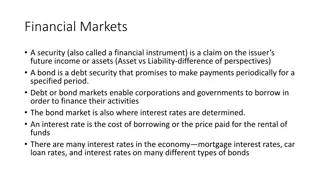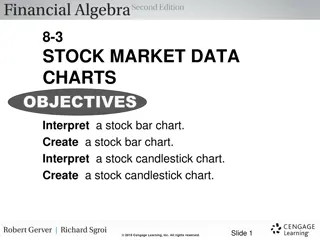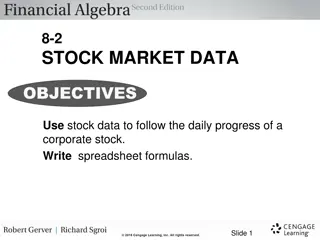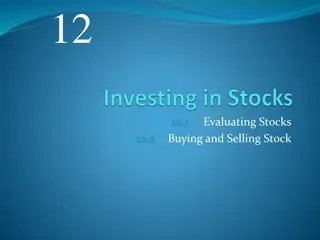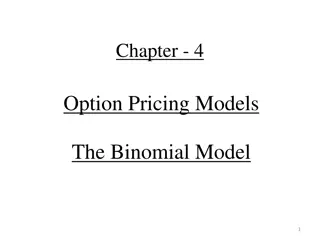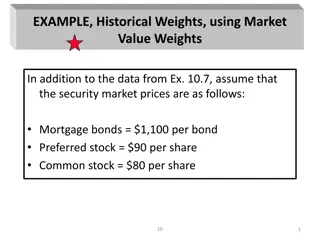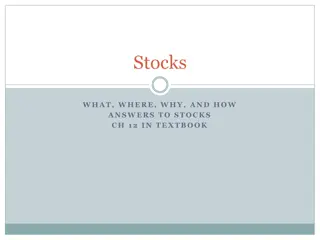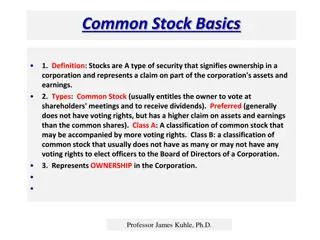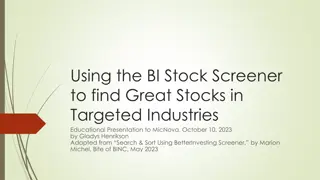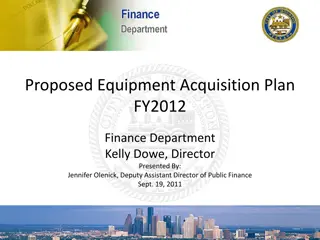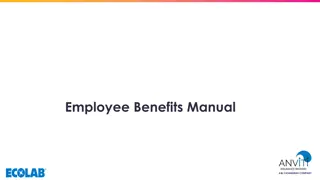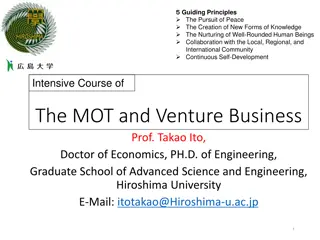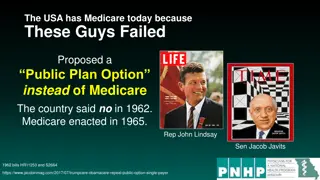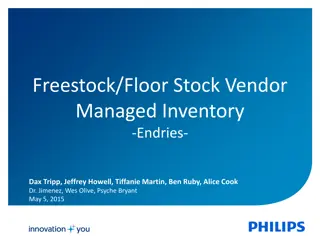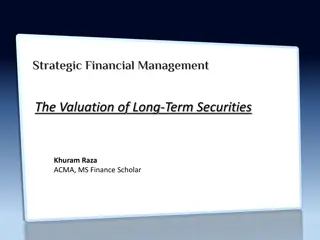Employee Stock Option Plan Presentation and Guide
This presentation and guide cover the Employee Stock Option Plan, including Black-Scholes Model, practical challenges, market research, and relevant standards like Ind AS 102. It provides an in-depth overview of share-based payments, recognition, measurement, and disclosure requirements, along with examples and insights for listed and non-listed companies. The comprehensive content is aimed at helping individuals understand ESOPs and related financial concepts.
Download Presentation

Please find below an Image/Link to download the presentation.
The content on the website is provided AS IS for your information and personal use only. It may not be sold, licensed, or shared on other websites without obtaining consent from the author.If you encounter any issues during the download, it is possible that the publisher has removed the file from their server.
You are allowed to download the files provided on this website for personal or commercial use, subject to the condition that they are used lawfully. All files are the property of their respective owners.
The content on the website is provided AS IS for your information and personal use only. It may not be sold, licensed, or shared on other websites without obtaining consent from the author.
E N D
Presentation Transcript
Employee Stock Option Plan Presenter: Guide: Shri K K Wadhwa, FIAI Consulting Actuary Khushwant Pahwa, FIAI, FIA Founder and Consulting Actuary KPAC (Actuaries and Consultants)
Agenda Look at the Reference Material Black-Scholes Model Live Example Listed Company Practical Challenges Non Listed Companies Market Research Questions
The Black Scholes Formulas Reference material an overview Reference material provided contains necessary reading material for ESOPs: Ind AS 102: Share Based Payments GN on Share Based Payments Ind AS 101: First time Adoption SEBI Guidelines: - SEBI (Employee Stock Option Scheme And Employee Stock Purchase Scheme) Guidelines, 1999 - SEBI (Share Based Employee Benefits) Regulations, 2014 CT8 Chapter 12 (The Binomial Model) CT8 Chapter 13 (The Black-Scholes option pricing formula) Mayur Ankolekar s presentation on ESOPs Let is take a quick overview of each of above
The Black Scholes Formulas Ind AS 102: Share Based Payments (1/4) 35 page Standard covering Share Based Payments. Specifies Recognition, Measurement and Disclosure with regards to share based transactions. Standard is divided into 3 main parts: - Main Standard, containing Scope, Recognition, Measurement and Disclosure Requirements. - Appendix A, giving major definitions - Appendix B, which provides guidance on application of the standard Appendices are an integral part of the Standard. Overview of above parts given in the following slides.
The Black Scholes Formulas Ind AS 102: Share Based Payments (2/4) Main Standard (16 pages) Recognition (11 pages) Disclosures (3 pages) Objectives & Scope (2 pages) Description of SBPT - Para 44, with 45 SBPT with choice of settlement Equity- Settled SBPT Cash- Settled SBPT Description of method / assumption estimate fair value of option - Para 46, with 47 to 49 used to Holder Writer Financial reporting of all SBPT, whether or not the entity can identify specifically some or all of the goods or services received For each SBPT: Recognition & Measurement Treatment of vesting condition (Market & Non- Market) Modification of terms & condition Settlement by group entities Expense to be recognized in P/L statement - Para 50, with 51 to 52
The Black Scholes Formulas Ind AS 102: Share Based Payments (3/4) Appendix A (5 pages) Appendix A defines following items: Performance condition Reload feature Reload option Service condition Share-based payment arrangement Share-based payment transaction Share option Vest Vesting condition Vesting period Cash-settled SBPT Employees and others providing similar services Equity instrument Equity instrument granted Equity-settled SBPT Fair Value Grant Date Intrinsic Value Market condition Measurement Date
The Black Scholes Formulas Ind AS 102: Share Based Payments (4/4) Appendix B (14 pages) Estimating fair value of equity instruments SBPT involving cash- settled payments Modification to SBPTs SBPT involving group entities Shares Share options Expected early exercise Expected volatility Expected dividend Risk free rate Capital structure effects
The Black Scholes Formulas GN on Share Based Payments (1/2) Largely similar to Ind AS 102: Share Based Payments Para 40 in GN permits Intrinsic Value Method to value the SBPT. Quoted below: There is another method known as the Intrinsic Value Method for valuation employee share based payment plans. Intrinsic value, in the case of a listed company, is the amount by which the quoted market price of the underlying share exceeds the exercise price of an option. For accounting for employee share-based payment plans, the intrinsic value may be used in place of the fair value as described in paragraphs 10 to 39. In the case of a non- listed company, since the shares are not quoted on a stock exchange, value of its shares is determined on the basis of a valuation report from an independent valuer. Valuation report of independent valuer is a hazy concept. Many valuers use the net worth as value, which in turn leads to underestimation of the fair value. The option valuer (e.g. the actuary) should have enough disclaimers in her/ his report on this aspect
The Black Scholes Formulas GN on Share Based Payments (2/2) Runs into about 85 pages, divided into: - Main regulations (22 pages): Guidance Note on Accounting for Employee Share-based Payments - Appendix 1 (10 pages): Estimating the Fair Value of Shares or Stock Options Granted - Appendix 2 (16 pages): Equity-settled Employee Share-based Payment Plans - Appendix 3 (4 pages): Modification to the Term and Conditions of Equity-settled Employee Share- based Payment Plans - Appendix 4 (7 pages): Cash-settled Employee Share-based Payment Plans - Appendix 5 (4 pages): Employee Share-based Payment Plans with Cash Alternatives - Appendix 6 (4 pages): Graded Vesting - Appendix 7 (12 pages): Accounting for Employee Share-based Payment Plans Administered Through a Trust - Appendix 8 (6 pages): Accounting for Employee Share-based Payment Plans Administered Through a Trust
The Black Scholes Formulas Ind AS 101: First Time Adoption (1/3) Ind AS 101 mandates retrospective implementation of standards. It also provides for certain exceptions and exemptions from first time adoption. Paras D2 and D3 in Ind AS 101 deal with Share Based Payments. Quoted below: D2 A first-time adopter is encouraged, but not required, to apply Ind AS 102 Share-based payment to equity instruments that vested before date of transition to Ind ASs. For all grants of equity instruments to which Ind AS 102 has not been applied (eg, equity instruments vested but not settled before date of transition to Ind ASs, a first time adopter shall nevertheless disclose the information required by paragraphs 44 and 45 of Ind AS 102. D3 A first-time adopter is encouraged, but not required, to apply Ind AS 102 to liabilities arising from share-based payment transactions that were settled before the date of transition to Ind ASs.
The Black Scholes Formulas Managing Transition: Equity Settled SBPT (2/3) Equity-Settled Share Based Payment Transactions Vested options but not yet exercised Options vested and exercised Un-Vested options Require accounting for ESOPs as per Ind AS 102 Not required to apply Ind AS 102 Encouraged but not required to apply Ind AS 102 All recognized. expense will be recognized compared to Intrinsic Value Method expenses not Additional yet No adjustment needed as transaction has been fully settled All expenses recognized. No further adjustment needed. Need to value options again as at grant date using fair value method
The Black Scholes Formulas Managing Transition: Equity Settled SBPT (3/3) Cash-Settled Share Based Payment Transactions Vested SARs but not yet settled Un-Vested SARs SARs vested and settled Require accounting for ESOPs as per Ind AS 102 Encouraged but not required to apply Ind AS 102 Require accounting for ESOPs as per Ind AS 102 All recognized. expense will be recognized compared to Intrinsic Value Method expenses not Additional yet No adjustment needed as transaction has been fully settled All recognized. expense will be recognized compared to Intrinsic Value Method expenses not Additional yet Need to value options at each previous reporting date from grant date using fair value method until vested.
The Black Scholes Formulas SEBI Guidelines Securities And Exchange Board Of India (Employee Stock Option Scheme And Employee Stock Purchase Scheme) Guidelines, 1999 Issued in 1999 but amended up to 2009. New regulations: SECURITIES AND EXCHANGE BOARD OF INDIA (SHARE BASED EMPLOYEE BENEFITS) REGULATIONS, 2014 Applies to Employee Stock Option Scheme and Employee Stock Purchase Scheme. Applies to any company whose shares are listed on any recognised stock exchange in India. Runs into 35 pages, divided into: - Main regulations (22 pages): Gives requirements to comply with regards to ESPS and ESOPs. Key requirements discussed in further slides. - Schedule 1 (4 pages): Accounting Policies for ESOS - Schedule 2 (1 page): Accounting Policies for ESPS - Schedule 3 (1 page): Fair value of options - Schedule 4 (2 pages): Disclosure document - Schedule 5 (4 pages): Information required in statement to be filed with Stock Exchange - Schedule 6 (1 Page): Format of notification for issue of shares under stock option plans.
The Black Scholes Formulas SEBI Guidelines Main Regulations PART A: ESOS Deals with Eligibility to participate in ESOS. Disqualifies the following persons: - An employee who is a promoter or belongs to the promoter group shall not be eligible to participate in the ESOS. - A director who either by himself or through his relative or through any body corporate, directly or indirectly holds more than 10% of the outstanding equity shares of the company shall not be eligible to participate in the ESOS. Requires constitution of Compensation Committee. - Committee of the Board of directors consisting of a majority of independent directors. - Compensation Committee shall formulate the detailed terms and conditions of the ESOS Requires Shareholder Approval for grant of ESOPs. - Shareholders need to approve ESOS by passing a special resolution in the general meeting. Lays down procedure for variation of terms of ESOS - Prohibits variation to the terms of the ESOS in any manner, which may be detrimental to the interests of the employees
The Black Scholes Formulas SEBI Guidelines Main Regulations PART A: ESOS Talks about Pricing of ESOPs. - Gives freedom to determine the exercise price subject to conforming to the accounting policies specified in clause 13.1. - Requires that in case a company calculates the employee cost using intrinsic value, the difference in cost based on the fair value of the options shall be disclosed in the Directors report and also the impact of this difference on profits and on Earning Per Share of the company shall also be disclosed in the Directors report Disclosure in the Directors' Report - Various disclosures, largely in line with disclosure requirement in Ind AS 102 on Share Based Payments - Requires that in case a company calculates the employee cost using intrinsic value, the difference in cost based on the fair value of the options shall be disclosed in the Directors report and also the impact of this difference on profits and on Earning Per Share of the company shall also be disclosed in the Directors report. PART B: ESPS (not discussed in this presentation)
The Black Scholes Formulas SEBI Guidelines: Schedule 1: Accounting Policies for ESOS Permits both intrinsic value and fair value methods of measure. Intrinsic value approach to become irrelevant as the Companies start reporting on IFRS converged Ind AS basis. Suggests accounting approach and entries which are in line with requirements of Ind AS 102 and discussed later in the presentation. Contradicts Ind AS 102 with respect to lapsation of vested options: When a vested option lapses on expiry of the exercise period, after the fair value of the option has already been accounted for as employee compensation, this accounting treatment shall be reversed by a credit to employee compensation expense. Para 22 of Ind AS 102, which reads as under, does not permit such reversal: Having recognised the goods or services received in accordance with paragraphs 10 22, and a corresponding increase in equity, the entity shall make no subsequent adjustment to total equity after vesting date. For example, the entity shall not subsequently reverse the amount recognised for services received from an employee if the vested equity instruments are later forfeited or, in the case of share options, the options are not exercised. However, this requirement does not preclude the entity from recognising a transfer within equity, ie a transfer from one component of equity to another.
Agenda Look at the Reference Material Black-Scholes Model Live Example Listed Company Practical Challenges Non Listed Companies Market Research Questions
The Black Scholes Formulas Black-Scholes Formula: (Ignoring dividends) Price of Call Option (C) = S * N (d1) - K * e r (T - t) * N (d2) Where: d1 = [Ln (S0 / K) + (r + 2 / 2) * (T - t) ] / ((T - t)0.5) d2 = [Ln (S0 / K) + (r - 2 / 2) * (T - t) ] / ((T - t)0.5) = d1 - ((T - t)0.5) S = Stock Price on the date of Valuation K = Strike Price of Call Option r = risk free rate of return T = Expiry Time in years t = Current Time in years = Annualised volatility of the Stock
The Black Scholes Formulas Black-Scholes Formula intuitive explanation Price of Call Option (C) = S * N (d1) - K * e r (T - t) * N (d2) RHS of equation = Cost of replicating portfolio Cost of setting up hedging portfolio on right side of equation Seller of call option: - - buys some amount of shares at current price S, and goes short on risk free bond that equals to K at expiration if the option finishes in money. e r (T - t) is the discount (present valuing) factor Mysterious N(d1) must be the number of shares of the stock to go long today Mysterious N(d2) must be probability that option will finish in the money. Both N(d1) and N(d2) change as the underlying stock price and the time to expiration change. This is why one needs to adjust the hedging portfolio continuously. The Intuition Behind Option Valuation: A Teaching Note By Thomas Grossman, Haskayne School of Business, University of Calgary. Link: http://www.slu.edu/~chakrab/readings/Valuing_Options.pdf
The Black Scholes Formulas Black-Scholes Formula Assumptions Assumptions used in Black Scholes formula: Underlying share price follows Geometric Brownian motion Market is arbitrage-free Risk-free rate r is constant and the same for all borrowing and lending Assets may be bought and sold at any time t > 0 Assets may be held in any amount There are no taxes or transaction costs One can criticise quite easily the individual assumptions. Example: Share prices can jump, invalidating assumption 1 since Geometric Brownian motion has continuous sample paths. The risk-free rate of interest does vary and in an unpredictable way. Despite potential flaws in assumptions, analyses of market derivative prices indicate that the Black- Scholes model does give a very good approximation to the market. In this respect, Black-Scholes model is a good model since it gives prices which are close to observed market prices and because it provides insight into the usefulness of dynamic hedging. Let us see in context of a listed share in India how close does the Black Scholes Model give the price.
The Black Scholes Formulas 3 things in this section Black Scholes Formula Finding Comparing Theoretical Price with Market Price Exploring one online calculator Theoretical Price of traded option Black Scholes formula used to calculate Theoretical Price of traded call options. Using parameters / inputs observed in the market to price the option. Call options traded in the market are short term (up to 3 months). Calculations done for INFOSYS LIMITED as on 23 February 2017 for Call Options maturing on 30 March 2017. ESOPs are Call Options with Longer Term plus Added Complications (e.g. American Call Option, Restriction on sale, etc) Note: Explaining details and derivation of Black Scholes Formula not the purpose of this presentation.
Lets take a live case INFOSYS LIMITED Stock Price Strike Price 1,080 1,050 1006.55 1000 1,020 990 960 930 900 Exercise Price (X) Rs. 1000.00 Type of Option Call Option (European) Valuation Date 23 Feb 2017 Stock Price Rs. 1006.55 Expiry Date 30 March 2017 Term to maturity 0.10 years (approx.)
Now, lets look into what inputs are required Inputs to the BS Model Valuation Date 23 Feb 2017 Exercise Price (X) Rs. 1000.00 Stock Price as at Grant Date (S) Rs. 1006.55 Time to expiration ( T t, in year) 0.10 years (approx.) Risk-free rate of return (r) 6.00% Dividend Yield 0.00% Annualized Volatility ( ) 23.05% Points to note: Annualized Volatility (shown above) has been calculated based on the share price data of past one year (252 trading days) which has been taken from the NSE website. As per NSE website implied volatility is 21.22%.
Finally the outputs Output from the BS Model d1 = ln(S/X) + (r + ( ^2)/2)*(T - t) * (T - t) d1 20.77% d2 13.64% N(d1) 58.23% d2 = d1 - * (T - t) N(-d1) 41.77% N(d2) 55.42% N(-d2) 44.58% c = S*N(d1) N(d2)*K*e^(-r*(T - t)) Price of Call Option Rs. 35.05 Price of Put Option Rs. 22.76 p = N(-d2)*K*e^(-r*(T - t)) S*N(- d1) Put Call Parity check (Using the calculated assumed volatility) c S = p - K*e^(-r*(T - t)) TRUE
Now, lets look into few more cases Option Price (as per excel model) S. No. Strike Price Option Price (NSE)* 1 960 61.33 62.10 2 980 47.16 47.00 3 1,000 35.05 35.00 4 1,020 25.13 26.25 5 1,040 17.35 18.95 *Stock price, Term to maturity, Risk-free rate of interest and Volatility have been kept same with the previous example.
Snapshot 2 (Option prices at different strike prices) Snapshot: Option Chain NSE Website
Option prices at different share prices Option Price = Intrinsic Value + Option Value 106 91 Option Price Intrinsic Value Option Value (OP - IV) 76 Option Price 61 46 31 16 1 900 920 940 960 980 1000 1020 1040 1060 1080 1100 Underlying share price Intrinsic Value Time Value = = Share Price Strike Price Option Price Intrinsic Value
Black-Scholes Online Model As BS model is fairly a simple model so instead of creating, one can also use free online models. One such magical website is www.fintools.com.
Agenda Look at the Reference Material Black-Scholes Model Live Example Listed Company Practical Challenges Non Listed Companies Market Research Questions
Accounting Treatment: Equity-settled SBPT For equity-settled SBPT, entity shall measure their value, and corresponding increase in equity, by reference to fair value of the equity instruments granted. If equity instruments granted vest immediately, recognize the expense and corresponding increase in equity immediately. If equity instruments granted do not vest until a specified period of service, recognize cost and the corresponding increase in equity over the vesting period. Measure the fair value of equity instruments granted at the measurement date, taking into account terms and conditions upon which those equity instruments were granted. Grant of equity instruments may be conditional upon satisfying specified vesting conditions i.e. market and non-market conditions. - Adjust market condition in determination of Fair Value - Adjust non market condition in estimate of number of options likely to vest.
Example 1: Equity-settled ESOPS Vesting Date: 3 years Must be exercised immediately Grant Date: 1,000 * 100 ESOPS Strike Price: Rs. 1000 23 Feb 2020 23 Feb 17 31 Mar 2017 31 Mar 2018 31 Mar 2019 31 Mar 2020 Infosys Ltd grants 1,000 share options (ESOPs 2017) each to its 100 employees on 23 February 2017. Grant is conditional upon the employee working for the entity over the next three years. Options are to be immediately exercised after three years. Strike Price = Rs. 1,000. On the basis of attrition trend, the entity expects 20% of the employees to leave each year, which will result in the forfeiture of their options. We need to determine accounting for FY 2016-17, FY2017-18, FY2018-19 and FY2019-20.
Step 1: Determine Fair Value on Grant Date Vesting Date: 3 years Must be exercised immediately Grant Date: 1,000 * 100 ESOPS Strike Price: Rs. 1000 23 Feb 2020 23 Feb 17 31 Mar 2017 31 Mar 2018 31 Mar 2019 31 Mar 2020 Valuation Date 23 Feb 2017 Exercise Price (X) Rs. 1000.00 Stock Price as at Grant Date (S) Rs. 1006.55 Time to expiration ( T t, in year) 3 years Risk-free rate of return (r) 6.00% Dividend Yield 0.00% Annualized Volatility ( ) 23.05% Price of Call Option Rs. 246.72 Total Worth of Options Granted Rs. 24,672,000
Step 2: Determine options expected to vest 23 Feb 17 23 Feb 19 23 Feb 18 23 Feb 2020 31 Mar 2017 31 Mar 2018 31 Mar 2019 31 Mar 2020 12,800 ESOPs Lapsed (1,000 * 100 * .20^3) 20,000 ESOPs Lapsed (1,000 * 100 * .20) 16,000 ESOPs Lapsed (1,000 * 100 * .20^2) 80,000 ESOPs 64,000 ESOPs 51,200 ESOPs Options expected to vest as on 23 Feb 2020 51,200 Options Total expected cost to be recognized during the three year period Rs. 12,632,064 ( 51,200 * 246.72 )
Step 3: Determine expense to be recognized each year 23 Feb 17 23 Feb 19 23 Feb 18 23 Feb 2020 31 Mar 2017 31 Mar 2018 31 Mar 2019 31 Mar 2020 Rs. 3,789,619 ( 12,632,064 * .90 / 3 ) Rs. 4,210,688 ( 12,632,064 * 1 / 3 ) Rs. 412,069 ( 12,632,064 * .10 / 3 ) Rs. 4,210,688 ( 12,632,064 * 1 / 3 ) Expense to be recognized during each year (Rs.) Date Cumulative Expense (Rs.) 421,069 31 March 2017 421,069 ( 12,632,064 * .10 / 3 ) 4,631,757 31 March 2018 4,210,688 ( 12,632,064 * 1.10 / 3 ) 8,842,445 31 March 2019 4,210,688 ( 12,632,064 * 2.10 / 3 ) 12,632,064 ( 12,632,064 * 3 / 3 ) 23 Feb 2020 3,789,619
Accounting Entries: Assuming actual attrition hold (1/3) Debit (Rs.) Credit (Rs.) Date Particulars 421,069 Employee compensation expense account Dr To ESOP outstanding account 421,069 31 March 2017 (Being grant of 100,000 options to employees worth Rs. 246.72 amortized on straight line basis over 3 years) 421,069 Profit and loss account Dr To Employee compensation expense account 421,069 31 March 2017 (Being expenses transferred to P/L account at year end) 4,210,688 Employee compensation expense account Dr To ESOP outstanding account 4,210,688 31 March 2018 (Being grant of 100,000 options to employees worth Rs. 246.72 amortized on straight line basis over 3 years) 4,210,688 Profit and loss account Dr To Employee compensation expense account 4,210,688 31 March 2018 (Being expenses transferred to P/L account at year end)
Accounting Entries: Assuming actual attrition hold (2/3) Debit (Rs.) Credit (Rs.) Date Particulars 4,210,688 Employee compensation expense account Dr To ESOP outstanding account 4,210,688 31 March 2019 (Being grant of 100,000 options to employees worth Rs. 246.72 amortized on straight line basis over 3 years) 4,210,688 Profit and loss account Dr To Employee compensation expense account 4,210,688 31 March 2019 (Being expenses transferred to P/L account at year end) 3,789,619 Employee compensation expense account Dr To ESOP outstanding account 3,789,619 23 Feb 2020 (Being grant of 100,000 options to employees worth Rs. 246.72 amortized on straight line basis over 3 years) 3,789,619 Profit and loss account Dr To Employee compensation expense account 3,789,619 23 Feb 2020 (Being expenses transferred to P/L account at year end)
Accounting Entries: Assuming actual attrition hold (3/3) Last Entries (b) (a) If all vested options get lapsed If all vested options get exercised Date Particulars Debit (Rs.) Credit (Rs.) Bank account (51200 * 1000) Dr ESOP outstanding account Dr To Equity Share capital account (51200 * 5) To Share Premium account (Balancing Item) 51,200,000 12,632,064 23 Feb 2020 (a) 256,000* 63,576,064 (Being 51,200 employee stock options exercised) ESOP outstanding account Dr To General reserve account 12,632,064 12,632,064 23 Feb 2020 (b) (Being 51,200 employee stock options get lapsed) *Face value of the shares is Rs. 5. This has been taken from the NSE website.
Disclosures as on 31 March 2017 Description of share based payment arrangements refer to para 45 (a) of Ind AS 102 Particulars ESOPs 2017 ESOPs Granted 100,000 Method of settlement Equity Settled Grant Date 23 Feb 2017 Vesting Requirement 3 years from grant date Exercise Price Rs. 1,000 Share price as at grant date Rs. 1006.55 Exercise Date 24 Feb 2020
Disclosures as on 31 March 2017 No. of Options movement during the year refer to para 45 (b) of Ind AS 102 Particulars 31-03-17 31-03-18 31-03-19 31-03-20 Options O/S at the beginning 0 98,000 78,400 62,720 Options Granted during the year 100,000 0 0 0 Options Forfeited during the year 2,000 19,600 15,680 11,520 Options Exercised during the year 0 0 0 51,200 Options Expired during the year 0 0 0 0 Options O/S at the end 98,000 78,400 62,720 0 Options Exercisable at the end 0 0 0 0
Disclosures as on 31 March 2017 Weighted-average exercise prices of options refer to para 45 (b) of Ind AS 102 Particulars 31-03-17 31-03-18 31-03-19 31-03-20 Weighted average exercise price for the share options outstanding at the end (Rs.) 1,000 1,000 1,000 N/A Weighted average exercise price for the share options exercised during the period (Rs.) N/A N/A N/A 1,000 Weighted-average fair values and remaining contractual life of options refer to para 45 (c) of Ind AS 102 Particulars 31-03-17 31-03-18 31-03-19 31-03-20 Weighted average share price as at the exercise date (Rs.) N/A N/A N/A 1,280* Weighted average contractual life of the share options 2.9 1.9 0.9 - *For the sake of presentation we have assumed that the share price as at the exercise date will be Rs 1,280.
Disclosures as on 31 March 2017 Description of method / assumptions used to estimate the fair value of option refer to para 47 (a - i) of Ind AS 102 Particulars ESOPs 2017 Option Price Model Black Scholes Method Share Price as at grant date (Rs.) 1,006.55 Exercise Price (Rs.) 1000.00 Expected Volatility 23.05% Exercise Date 24 Feb 2020 Time to expiration ( T t, in year) 3 years Risk-free rate of return (r) 6.00% Dividend Yield 0.00% Fair Value of Options as at grant date: Rs. 246.72
Disclosures as on 31 March 2017 Other key information on fair value of options refer to para 47 (a ii) of Ind AS 102 1. The measure of volatility used in option pricing model is the annualized standard deviation of the continuously compounded rates of return on the share over a one year period of time. 2. Implied volatility as per the NSE website is 21.22%, which has been calculated using all the same inputs (mentioned in previous section) except the term to maturity. Please note that the implied volatility mentioned here is for an option expiring at 30 March 2017. Since the term of the ESOP is longer, the Company has used volatility of share price actually observed over the past term consistent with the term of the ESOPs granted. 3. Closing price of the Company s shares on NSE website on the grant date has been considered. Risk-free rate of return considered is based on yields on Indian government bonds. 4. Expense to be recognized in P/L statement refer to para 50 of Ind AS 102 Particulars 31-03-17 31-03-18 31-03-19 31-03-20 Expense recognized during the period (Rs.) 421,069 4,210,688 4,210,688 3,789,619
Example 1A: Example 1 + Actual Attrition Varies Let us assume everything does not go as planned and actual attrition rate assumption does not hold. During second year, only 10% of the employees leave the organization, hence the entity revise the attrition rate assumption from 20% p.a. to 15% p.a.. Let us discuss the accounting treatment.
Step 2: Determine options expected to vest 23 Feb 17 23 Feb 19 23 Feb 18 23 Feb 2020 31 Mar 2017 31 Mar 2018 31 Mar 2019 31 Mar 2020 10,500 ESOPs Lapsed (70,000 * .15) 20,000 ESOPs Lapsed (1,000 * 100 * .20) 10,000 ESOPs Lapsed (1,000 * 100 * .10) 80,000 ESOPs 70,000 ESOPs 59,500 ESOPs Options expected to vest as on 23 Feb 2020 59,500 Options Total expected cost to be recognized during the three year period Rs. 14,679,840 ( 59,500 * 246.72 )
Step 3: Determine expense to be recognized each year (Already sitting as on 31 March 2019) 23 Feb 17 23 Feb 19 23 Feb 18 23 Feb 2020 31 Mar 2017 31 Mar 2018 31 Mar 2019 31 Mar 2020 Rs. 10,275,888 ( 14,679,840 * 2.1 / 3 ) Rs. 412,069 ( 12,632,064 * .10 / 3 ) Rs. 4,631,757 ( 12,632,064 * 1.1 / 3 ) Rs. 14,679,840 ( 14,679,840 * 3 / 3 ) Expense to be recognized during each year (as per plan) Cumulative Expenses (as per plan) Actual Expense to be recognized during each year Actual Cumulative Expense Date 31 March 2017 421,069 421,069 421,069 421,069 31 March 2018 4,210,688 4,631,757 4,210,688 4,631,757 31 March 2019 4,210,688 8,842,445 5,644,131 10,275,888 23 Feb 2020 3,789,619 12,632,064 4,403,952 14,679,840
Accounting Entries: Assuming actual attrition doesnt hold (1/3) Debit (Rs.) Credit (Rs.) Date Particulars 421,069 Employee compensation expense account Dr To ESOP outstanding account 421,069 31 March 2017 (Being grant of 100,000 options to employees worth Rs. 246.72 amortized on straight line basis over 3 years) 421,069 Profit and loss account Dr To Employee compensation expense account 421,069 31 March 2017 (Being expenses transferred to P/L account at year end) 4,210,688 Employee compensation expense account Dr To ESOP outstanding account 4,210,688 31 March 2018 (Being grant of 100,000 options to employees worth Rs. 246.72 amortized on straight line basis over 3 years) 4,210,688 Profit and loss account Dr To Employee compensation expense account 4,210,688 31 March 2018 (Being expenses transferred to P/L account at year end)




